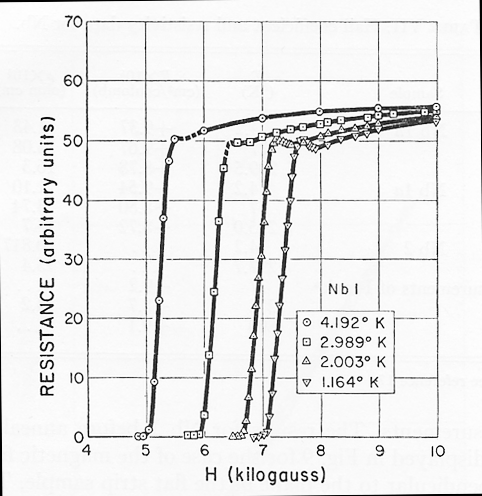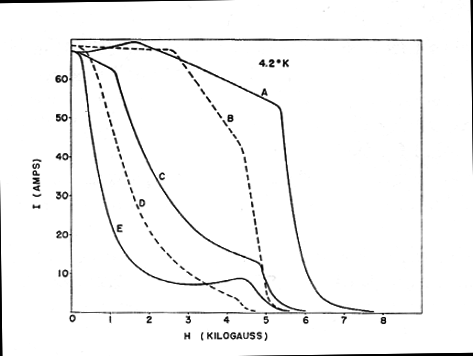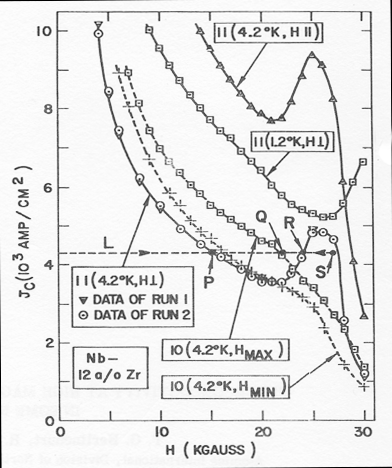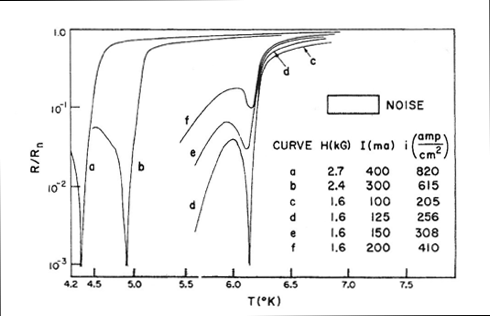Earliest Sightings and Cause of the Superconductivity Peak Effect
By T. G. Berlincourt (Past Affiliations: Naval Research Laboratory, Atomics International, Colorado State University, Office of Naval Research, and Office of the Secretary of Defense.)
The superconductivity peak effect first appeared in 1959 as a tiny blip1 (Figure 1). It occurred when an increasing, transverse magnetic field was restoring resistance to a strip of superconducting Nb (now known to be a Type II superconductor), while it was carrying a constant current and being held at a constant temperature. At the two highest measurement temperatures, the data points were too-widely dispersed to reveal the blip. But, at 2ºK a small departure from the expected monotonic increase of resistance with increase of magnetic field appeared unexpectedly. The anomaly was first noted with considerable puzzlement by Donald H. Leslie, who was recording the data. A tightening of the measurement intervals at the two lowest temperatures, revealed the full extent of the blip. As is evident in Figure 1, at 2ºK and 1ºK, with increasing magnetic field, the resistance first rose to a maximum, then fell 3% to a minimum, and finally rose again to restore the full normal-state electrical resistance. At the time, the blip didn’t appear to be much to get excited about. However, to the best of my knowledge, such non-monotonic behavior had not previously been reported for any of the vast number of previously-observed, magnetic-field-induced resistive transitions from the superconducting state to the normal state. Significantly, over a small magnetic field range (from the maximum resistance to the minimum), the resistance decreased as the magnetic field was increased, thereby violating the long-held belief that an increase of magnetic field always acts to degrade measurements of superconductivity. In fact, it appeared that the specimen entered a more-robust super phase before ultimately capitulating to the increasing magnetic field. Perhaps, in that light, the blip just might have been a bit noteworthy. Nevertheless, that first observation of the electrical-resistance-vs-magnetic-field peak effect (RHPE) was little noted, for, at that time, the experimental and theoretical understanding of superconductivity was simply not up to the task of determining the cause of the blip, nor whether it was merely a triviality, or perhaps a faint glimpse into a new realm of physics. Interestingly, the peak effect would soon appear in other types of superconductivity measurements as well. But before discussing them, it‘s appropriate to provide some background on superconductivity.

Figure. 1. First appearance of the peak effect in the electrical resistance vs transverse magnetic field for a Nb strip at various temperatures. (Reference 1.)
When cooled sufficiently, some metals undergo abrupt transitions to the superconducting state. Remarkably, in that state they present no resistance whatsoever to the passage of an electric current. But there is much more to superconductivity than zero electrical resistivity. A superconductor can be driven into the normal state by increasing its temperature, by increasing the applied magnetic field, or by increasing the electric current fed through it. Moreover, depending upon temperature, applied magnetic field, and applied electric current density, superconductors exhibit a vast array of bizarre quantum mechanical properties that enable myriad revolutionary applications. This paper focusses on but one of the many peculiar aspects of superconductivity, viz., the peak effect in the mixed state, or magnetic vortex state, of a Type II superconductor. (Readers interested in exploring additional aspects of superconductivity and a few significant applications are referred to my earlier paper2 on the Type II superconducting alloy, niobium-titanium.)
So, what is a Type II superconductor, and what is the nature of its mixed state? If a Type II superconductor is cooled below its characteristic critical transition temperature (Tc) and is subjected to a magnetic field less than its characteristic lower critical field (Hc1), electric currents arise spontaneously in a thin surface layer of the Type II superconductor and completely shield its interior from the applied magnetic field. This zero-magnetic-field phase is known as the Meissner phase. When the applied magnetic field exceeds Hc1, the surface currents are no longer capable of shielding the interior of the Type II superconductor from the applied magnetic field, and the Type II superconductor transitions to the mixed state or magnetic vortex state, which persists from Hc1 to a characteristic upper critical field (Hc2), above which the interior of the Type II superconductor reverts to the normal state. The nature of this remarkable magnetic vortex phase was predicted theoretically by Alexi A. Abrikosov.3 In recognition of that accomplishment, he was awarded a Nobel prize in 2003. He predicted that between Hc1 and Hc2 the gradual penetration of the magnetic field into the interior of a Type II superconductor takes place via single-quantum fluxoids, i.e., tiny quantized supercurrent vortices, or discrete flux bundles. (Just as electric charge is not divisible into units less than the charge of an electron, so magnetic flux is not divisible into units less than the single quantum fluxoid, i.e., both electric charge and magnetic flux are quantized.) Abrikosov further predicted that just above Hc1 there would be a low density of independent fluxoids, but that, with increasing magnetic field penetration and greater density of fluxoids, the fluxoids would interact with one another and crystalize, forming a two-dimensional lattice array. He further suggested that inhomogeneities would tend to compromise the perfect periodicity of the lattice array. The implication was that fluxoids would be attracted to and pinned by minute inhomogeneous regions where superconductivity was weaker and repelled by regions where superconductivity was stronger.
When Abrikosov’s theory was published in 1957, it received scant attention, despite the fact that Abrikosov had cited extensive existing experimental corroboration of the macroscopic features of his theory. Experimental corroboration of the theory’s microscopic features, flux quantization and the vortex lattice, would come only years later, well after the first appearance of the peak effect. Consequently, there was then no microscopic basis for attempting an explanation of the peak effect in terms of the vortex lattice. Moreover, as already noted, prior to observation of the peak effect, it was believed that subjecting a superconductor to increases of applied magnetic field, imposed transport electric current density, and temperature (individually and in combination) would always impact measures of superconductivity adversely.
A year after the first appearance of the peak effect, Marcel A.R. LeBlanc and William A. Little4 measured the critical current density (Jc, the maximum dissipationless transport electric current density that a superconductor can carry without transitioning to the normal state) as a function of increasing transverse magnetic field for a Nb strip held at a constant temperature, and they also observed a peak anomaly. Instead of falling monotonically to zero at the critical magnetic field, as expected, the critical current density first fell to a minimum and then rose to a maximum, before finally falling to zero at the critical magnetic field Hc2 (Curve E, Figure 2). In that instance, between the minimum and the maximum, the increasing magnetic field and the increasing electric current appeared to be cooperating to enhance superconductivity. And, significantly, in this critical-current-vs-magnetic-field peak effect (CCHPE) the minimum lay a full 18% lower than the maximum. That much-more-impressive anomaly certainly merited attention. But, it was almost immediately overshadowed by the startling discovery by John E. Kunzler, Ernest Beuler, F.S.L. Hsu, and Jack H. Wernick5 that, at 4.2ºK, the metallic compound Nb3Sn was able to pass transport electric current densities greater than 100,000 amperes/cm2 without dissipation in the presence of a magnetic field of 8.8 tesla. Needless to say, that attracted everyone’s attention, and it set off an intense competition for discovery of additional high-magnetic-field, high-critical-current-density superconductors suitable for fabrication of supermagnets of unprecedented efficiency. Today such supermagnets find widespread application in MRI medical imagers and enormous elementary particle accelerators.
Together with my colleagues Richard R. Hake and Donald H. Leslie, I entered that competition. Early on, we found Nb-Zr alloys to be suitable for supermagnets generating magnetic fields up to 6 tesla,6 and that, not the peak effect, was uppermost in our minds at the time (1961). Nevertheless, in the course of those investigations, we observed both the CCHPE and the RHPE in the very same cold-rolled Nb-12 at.%Zr strip in a transverse magnetic field. In one instance (the lower of the two peaked curves, Figure 3), the critical-current-density minimum was 27% lower than the critical-current-density maximum. As for the RHPE, it was observed in a rather striking way by increasing the magnetic field at a constant current densityJc so as to pass through the anomalous Jc region, i.e., along the line L (Figure 3). As the magnetic field was increased, a resistive voltage first appeared at point P, reached a maximum at point Q, then disappeared at point R. The appearance and disappearance of resistive voltage was also observed upon lowering the field from point S. Significantly, that observation left no doubt that the RHPE and the CCHPE are simply different ways of viewing the same basic underlying phenomenon.
Not surprisingly, the influence of that underlying phenomenon is evident in a variety of other superconducting properties and types of measurements. One such additional example is particularly noteworthy. In 1962, S.H. Autler, E.S. Rosenblum, and K.H. Gooen7 observed very prominent electrical-resistance-versus-temperature peak effects (RTPE) for a Nb strip for a variety of constant transverse magnetic field strengths and for a variety of constant measuring current densities (Figure 4). Between the maximum and the minimum, the resistance decreased as temperature was increased, indicating that the increase of temperature was enhancing an indication of superconductivity.

Figure 2. Critical current vs magnetic field for various Nb specimens and various magnetic field orientations. The peak effect is evident in Curve E for a strip in a transverse magnetic field. (Reference 4.)

Figure 3. Critical current density, Jc, vs transverse magnetic field for various Nb-12 at.%Zr strip specimens and for various magnetic field orientations and for various temperatures. Prominent peak effects are evident. The line L is explained in the text. (Reference 6.)

Figure 4. For various constant transverse magnetic field strengths and for various constant measuring currents, prominent peak effects appear in the temperature dependence of the electrical resistance of a Nb wire divided by its normal-state electrical resistance (Reference 7.)
Taken altogether, the various peak effects provide conclusive evidence that, under certain circumstances, increases of applied magnetic field, transport electric current density, and temperature actually enhance measures of superconductivity. It is pertinent, however, that such peak effects appear only sporadically, depending on the types and density of imperfections in the experimental specimens, and on the orientation of the magnetic field relative to the specimen.
Curiously, for many decades, little progress was made toward understanding the cause of the peak effect. But eventually, peak-effect investigations became both fashionable and highly productive. Indeed, the internet is replete with peak-effect papers. What finally prompted that high level of activity? For one thing, the peak effect began appearing with great regularity in the remarkable high-temperature superconductors8 discovered in the late 1980s. For another, it became evident that there is much more to the mixed state of Type II superconductivity than Abrikosov’s unperturbed, perfectly-periodic, quantized-magnetic vortex lattice. Indeed, non-ideal Type II superconductors, of technical interest for supermagnet applications, contain a variety of deliberately-introduced inhomogeneities and imperfections, the more the better to pin vortices and enable support of large critical current densities. Those pinning sites perturb the ideal periodic magnetic vortex lattice structure, and, depending on temperature, magnetic field, transport current density, and types, strengths, and density of various vortex pinning sites, new phases of vortex matter appear, viz., a quasi-long-range-order Bragg glass phase, a disordered vortex glass phase, and a depinned vortex liquid phase. Those phases exhibit varying degrees of departure from the ideal periodic vortex lattice, with the Bragg glass phase exhibiting the least departure and the vortex liquid exhibiting the greatest departure. As applied magnetic field is increased above Hc1, the Bragg glass phase appears first, followed by the vortex glass phase and finally, near Hc2, the vortex liquid phase. Verifying and achieving understanding of those complex vortex phases has required extensive and highly-sophisticated theoretical and experimental investigations. Not surprisingly, the associated scientific literature concerned with those investigations is also vast. (See the comprehensive review by S.S. Banerjee, Shyam Mohan, Jaivardhan Sinha, Yuri Myasoedov, S. Ramakrishnan, and A.K. Grover.9) Oh, and the cause of the peak effect? In some instances,9 the peak effect is believed to be the consequence of an order-disorder transition between complex, vortex-matter phases. In other cases, when the peak occurs very close to Hc2, it’s believed10 to be a consequence of thermal fluctuations of individual vortices. In any event, the peak effect enhancement of measures of superconductivity with increasing magnetic field, critical current, or temperature implies the existence of an increase in vortex pinning as a causative factor. Discovery of the fundamental mechanism that might produce such a pinning increase awaits either a very clever experiment or development of a comprehensive theory capable of successfully taking into account the complex interactions between the various vortex phases and the types, strengths, density, and distribution of vortex pinning centers.
References
T.G. Berlincourt, Hall Effect, Resistivity, and Magnetoresistivity of Th, U, Zr, Ti, and Nb, Physical Review 114, 969 (1959).
T.G. Berlincourt, Superconducting Niobium-Titanium: Enabler for Affordable MRI and the Search for the Higgs Boson, Physics in Perspective 17, 334 (2015).
Alexei A. Abrikosov, On the Magnetic Properties of Superconductors of the Second Group, Zh, Eksperim. i. Teor. Fiz. 32, 1442 (1957). [English Translation: Soviet Physics. JETP 5, 1174 (1957).]
M.A.R. LeBlanc and W.A. Little, Critical Current for Superconducting Niobium Wire and Ribbons in External Magnetic Fields, Proceedings of the Seventh International Conference on Low Temperature Physics, (University of Toronto Press, Toronto, 1961) p. 362.
John E. Kunzler, ErnestBuehler, F.S.L. Hsu, and Jack H. Wernick, Superconductivity in Nb3Snat High Current Density in a Magnetic Field of 88k gauss, Phys.Rev.Lett. 6, 89 (1961).
T.G. Berlincourt, R.R. Hake, and D.H. Leslie, Superconductivity at High Magnetic Fields and Current Densities in Some Nb-Zr Alloys, Physical Review Letters 6, 671 (1961).
S.H. Autler, E.S. Rosenblum, and K.H. Gooen, High-Field Superconductivity in Niobium, Phys. Rev. Lett. 9, 489 (1962).
Johannes Georg Bednorz and Karl Alex Muller, Possible High Tc Superconductivity in the Ba-La-Cu-O System, Zeitschrift fur Physik-Condensed Matter B64, 189 (1986).
S.S. Banerjee, Shyam Mohan, Jaivardhan Sinha, Yuri Myasoedov, S. Ramakrishnan, and A.K. Grover, Nonlinear Response of the Static and Dynamic Phases of the Vortex Matter, Chapter 4, Superconductivity-Theory and Applications, Adir Luiz (Ed.), ISBN: 978-953-1151-0, InTech, (2011).
Rasmus Toft-Petersen, Asger B. Abrahamsen, Sandor Balog, Lionel Procar, and Mark Laver, Decomposing the Bragg Glass and the Peak effect in a Type-II Superconductor, Nature Communications 9, 901 (2018).
The articles in this issue represent the views of their authors and are not necessarily those of the Forum or APS.
